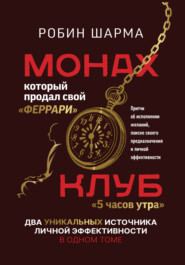По всем вопросам обращайтесь на: info@litportal.ru
(©) 2003-2024.
✖
Leadership Wisdom from the Monk Who Sold His Ferrari: The 8 Rituals of the Best Leaders
Автор
Год написания книги
2019
Настройки чтения
Размер шрифта
Высота строк
Поля
Julian then reached into his robe and pulled out the gold-plated golf ball that I’d returned to him.
“You’re not going to use that one are you? Do you have any idea how much that cost me Julian?” I asked, mildly irritated that my friend would use my special birthday present to him in his demonstration.
“Watch closely,” was the only reply I received as he focused intently on the hole at the other end of the fairway, his ultimate destination. Then with the ease and grace of a seasoned professional, he swung the club, striking the ball perfectly and sending it soaring high into the air. I’d never seen Julian hit the ball like that. However, in spite of his shot, it appeared as if the ball would fall short of its target. I looked at him and gave him my best “nice-try” expression.
Then something unbelievable happened. The ball seemed to speed up in the air, as if it had been blessed with the support of a convenient gust of wind. It now sped precisely toward its intended destination. A couple of groundskeepers, who had witnessed this display, had quickly taken off their hats so as not to miss seeing where the ball would land. Even a few of the golfers relaxing on the clubhouse verandah were leaning over the railing to see what would happen.
The ball then dropped down from the sky onto the green next to the first hole and began to roll slowly but directly toward it. No golfer had shot a hole in one on this course for quite some time, but perhaps my friend, adorned in the robe of a traditional monk and wearing nothing on his feet but his faithful sandals, would be the first to end this drought. The ball kept on inching toward the hole. Then it seemed to stop.
“Oh Julian,” I said, in sincere disappointment. “So close and yet so far.”
“Just wait, Peter. One of the leadership lessons I’ve learned is that immediately before a great victory, one will often experience some form of difficulty. The key is to maintain your focus and keep on believing.”
Then, just when it appeared to all that the ball had come to rest, it rolled the remaining two inches and dropped into the hole.
“Hurrah!” one of the groundskeepers shouted at the top of his lungs after witnessing this extraordinary event. Julian threw his fists into the air and began to do a little dance, obviously delighted by his achievement.
I simply laughed and shook my head. “Wow, Julian. You never cease to amaze me! Congratulations!”
After regaining my composure, I asked Julian how he did it. “Did you actually intend to shoot a hole in one?”
“I did. But to be honest, I wasn’t certain it would happen. I’d rehearsed that very shot on this very course hundreds of times in my mind when I was up in the Himalayas. It began to be a game I would play, just to keep my imagination sharp. I had great fun doing it. I must admit that even I’m a little surprised that my mental training produced such a fabulous result. But the fact it worked proves the important point I brought you down here to make,” offered Julian with a hint of mystery.
“Does it have something to do with the piece of the puzzle you gave me yesterday?”
“Yes, it does. Let me ask you this question, Peter. What do you think allowed me to shoot a hole in one the first time I stepped on a golf course after so many years?”
“Well, I think you answered the question yourself, Julian. It was because of your mental rehearsals during the time you were up in the Himalayas. You practiced doing what you just did so many times that you must have created something similar to a blueprint in your mind. Then you came down here today and, against the odds, translated that mental blueprint into reality.”
“Very good, Peter. You always had a quick mind and clearly understand the process I followed. I’m impressed.”
“You know I love the game of golf and will do anything to shave a couple of strokes off my game. So, over the past few months, I’ve been reading a lot of books on the lives and lessons of the world’s greatest golfers. If there was one thing they all agreed on, it was that ‘golf is a mental game.’ Jack Nicklaus, for example, mentioned that after walking the course he was about to play, he would envision the shots he hoped to make hundreds of times in his mind’s eye. This became his secret advantage. So when you told me you did the same thing, it really didn’t come as such a surprise.”
“And the greatest leaders in the world of business do the same thing,” Julian stated.
“They all visualize their golf shots?” I replied with a grin.
“No, Peter. They clearly envision their future paths in the present moment. They manufacture a crystal-clear blueprint or picture of what their companies will look like in the coming years. They know intimately the exact nature of the success they and their people are striving for. And every step they take is designed to move them closer to their vividly imagined future. In a word, my friend, they have a vision that inspires them to reach for the stars. That is the ultimate secret of their greatness as leaders.”
“It seems so simple. Just clearly envision my company’s future and I’ll become a great leader?” I queried.
“I didn’t mean to suggest it was that simple. There are many more leadership practices and philosophies followed by enlightened, high-performing leaders that allow them to lead as they do. Yogi Raman taught them all to me and I assure you I will soon share them with you. But, for now, just remember that great organizations begin with great leaders. And every great leader has bold dreams. Effective leaders are visionaries who craft clear pictures of their companies’ futures and then link them to the present activities of the people they are leading. In this way, all actions have a purpose: to bring the organizations closer to the result imagined by their leaders. It’s just like Woodrow Wilson said, ‘You are not here to merely make a living. You are here in order to enable the world to live more amply, with greater vision, with a finer spirit of hope and achievement. You are here to enrich the world, and you impoverish yourself if you forget that errand.’ ”
“So well said.”
“And remember, once you surrender to your vision, success begins to chase you. Ultimately, you really can’t pursue success, success ensues. It flows as the unintended by-product of effective efforts concentrated in the direction of a worthy purpose.”
“Yogi Raman, a monk living high in the Himalayas, taught you that?” I queried.
“Yogi Raman spent many years studying the fundamentals of leadership by studying the lives of history’s greatest leaders. He shared with me a timeless system that anyone in a leadership position can use to inspire and energize his or her team into action and raise the organization to heights previously unimagined. Yogi Raman might not have known all the complexities of the modern world of business here in the West, but he didn’t need to. The wisdom he shared with me is based on ancient leadership truths that have been passed down through the centuries. These truths could also be characterized as immutable laws since, like the laws of nature, they have stood the test of time and will continue to do so. And while the world of business is drowning in a sea of change, these truths for leading people are not.”
“So every great leader is a visionary. He or she has made a clear connection to the future by vividly imagining an end result. It’s kind of like what Henry Kissinger was quoted as saying in the paper a few years back, ‘The task of the leader is to get his people from where they are to where they have never been.’ Is that an accurate way to summarize what you are telling me?”
“Yes it is, Peter. You seem to have grasped the concept well, perfectly actually. But I’ll offer you another example anyway. Do you remember that famous eye surgeon we used to play golf with from time to time?”
“Sure. I really liked the guy. He had a wonderful sense of humor.”
“That’s him. He also used to organize that annual gala dinner and dance for all the ophthalmologists in the city. Remember what he named it?”
“How could I forget?” I replied with a grin. “The Eye Ball.”
“Well, one afternoon, we were out on the course and I remember him telling me about one of his very young patients who suffered from a medical condition known as amblyopia. Apparently, another doctor had mistakenly put a patch over the child’s good eye rather than the one that needed protection. After the patch was taken off, it was discovered, to the surprise and sadness of all concerned, that the little boy had completely lost the sight in that good eye. Apparently, the eye covering had stunted the development of his vision and caused blindness. That’s the phenomenon that the term amblyopia describes.”
“Remarkable.”
“I’ve never forgotten that story, Peter. I also think it applies to the leadership lesson I’m offering to you. In today’s business world, too many leaders become creatures of habit. They do the same things in the same way with the same people every day. They rarely have new thoughts, generate fresh ideas or take calculated risks. Instead, they confine their leadership to a secure area of comfort and refuse to leave it. Such leaders eventually suffer from their own form of amblyopia.”
“How so?”
“By spending their days doing the same old things, it’s like they’ve placed patches over their good eyes. They become unable to see the tremendous opportunities presented by these rapidly changing times. And, eventually, by not using their natural vision, they lose it and grow blind. Never let this happen to you, my friend. Take your blinders off and start looking for new opportunities. The best way to succeed in the future is to create it. As Helen Keller once said, ‘I’d rather be blind than have sight without vision.’”
Julian continued. “Now that you understand that the most enlightened and effective leaders are ‘visionary leaders,’ my duty is to give you the tools and skills to help you become one. And this is where Yogi Raman’s leadership system comes in.”
“First may I ask you a quick question?”
“Sure,” Julian replied as we strolled back to the clubhouse.
“I really want to learn what you have to teach me. You know that GlobalView is in big trouble. My best programmers are jumping ship, morale has been destroyed, no one trusts management and teamwork is a thing of the past. In an industry that demands relentless innovation, we seem to have lost our creative fire. And all the change that we are being forced to deal with is crippling my people. Technology is changing, the industry is changing and our customers’ expectations are changing. On top of all that, I just can’t seem to figure out the direction in which the company needs to move.”
I continued to share my frustrations with Julian. “What I’m really trying to tell you is that I know I need to improve my leadership abilities. At Digitech, I was promoted to higher and higher management positions. And though I went to a few leadership development courses here and there, in all those years, no one ever really took me aside and taught me how to lead people. No one ever showed me what to do to deeply motivate my team or communicate more effectively. No one explained how I could boost productivity while enhancing employee commitment. I’ve never even learned something as fundamental as the art of managing my time and getting things done.
“And now that I run my own company it’s even worse. I always seem to have far too much to do and too little time. Everyone expects me to have all the answers to all their questions. I’m constantly under stress and take out my frustration on my people, which only makes things worse. As for a sense of balance between my professional and personal life, it’s just a dream. I say to myself ‘next year will be the year I get back into shape or start spending more time with my family.’ But things never seem to slow down. So, if you don’t mind, I’m going to really take advantage of our time together and dig deep into the elements of great leadership. I want to ask you some of the basic questions I’ve always wanted to ask but never did, for fear of looking foolish.”
“Please do,” Julian replied gently.
“Okay. First of all, what does the word ‘leadership’ really mean? What does it really stand for? Though I’m running a huge company with more than 2,500 employees, I’ve never really been able to pinpoint the meaning of the word.”
“It’s like I said before, leadership is all about focused action in the direction of a worthy purpose. Leadership is about realizing that the impossible is generally the untried. Many people think that a leader is the man or the woman with the title of CEO or president. Actually, leadership is not about position, it is about action. Your managers can be great leaders. Your programmers can be great leaders. The shop foreman down on the factory floor can be a great leader. You see, Peter, to lead is to inspire, energize and influence. Leadership is not about managing things but about developing people. Visionary leaders are those who understand that the true assets of any organization go up the elevator in the morning and down it every night. Quite simply, leadership is about helping people to liberate the fullness of their talents while they pursue a vision you have helped them understand is a worthy and meaningful one. You can do this. Your managers can do this. Even your frontline workers can show leadership in the work that they do. And the truly effective leaders have to live in two places at once.”
“I’m not sure I understand you.”
“The best leaders recognize that leadership is a craft, not a gift. They constantly work to refine their art. And one of the things they work hardest to develop is an ability to be present-based but futurefocused. Great leaders have mastered the twin skills of managing the present while, at the same time, inventing the future. That’s why I say they have to live in two places at the same time. They need to live in the present and guide the improvement of current operations by enhancing quality, streamlining systems and raising customer-care standards. But at the same time, they must create, shape and nurture a clear blueprint for the future. Yogi Raman put it elegantly when he said, ‘The visionary leader is one who has learned how to focus on the summit while clearing the path.’ A company without a fanatical commitment to refining operations will soon be surpassed by its competition. But a company without a strikingly clear ideal to work toward will soon be out of business.”
“And is this where the piece of the jigsaw puzzle you left with me yesterday comes in?”
“Yes. Do you recall what the words on it said?” Julian asked.
Luckily, I had brought the piece with me and quickly lifted it from the front pocket of the yellow golf shirt I had on.

















